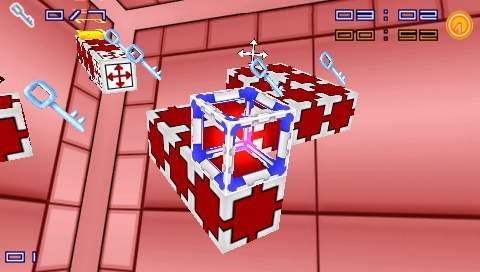Before you get too excited, know that Cube the game is not based on the 1997 sci-fi film, Cube. Instead, Cube is a puzzle game for the PlayStation Portable that has you moving a nondescript block around 135 abstract levels of varying degrees of difficulty. It's a fine concept, but unfortunately the puzzles in Cube are less a test of your spatial reasoning and more a test of your ability to situate the game's camera so you can see what you're doing. The uninspired puzzles are made all the more boring by the completely lifeless presentation in Cube. Even with the addition of a level editor and ad hoc multiplayer with game sharing, Cube just doesn't do enough to set it apart from numerous, better puzzle games already available for the PSP.

In Cube, you control a transparent cube that can move in four directions, with one side always connected to a solid object like a block. There is no gravity in the game, so you can move your cube along all sides of the blocks that make up the level. The goal of each level is to reach the exit panel, which is invariably tucked away behind barriers or hazards or floating on a distant, disconnected block. It's your job to hit switches that make barriers retract or make new blocks appear to create a path to the exit panel. Sometimes the puzzle is even simpler than that, merely requiring you to navigate a short path of connected cubes to reach the exit.
Many levels have hazards such as rolling mines, quicksand, or moving blocks that will crush you if you aren't careful. These hazards are usually easy to avoid if you can see them, but unfortunately the camera makes that more difficult than it should be. By default, the camera stays behind your block, and you can zoom in or out as desired. You can also press the R or L button to rotate the camera around your block to get a better viewing angle of the path ahead. Technically this works fine, but it's a pain to have to move one space, adjust the camera, move another space, adjust the camera, and so on for each move you make. It can also be incredibly confusing and disorienting to constantly change the camera angle, making it easy to get turned around upside down and backward.
Taking time to adjust the camera is tedious, and it impedes your success with the game. Each level has keys scattered about that you have to collect before reaching the exit. If you collect the keys and get to the exit within a set time limit, you get a gold medal for the level. As a result, every second counts, so while you're trying to make a break for the exit, you won't have time to futz with the camera. The easiest way to get a gold medal is to fail the level enough times to memorize exactly what you have to do step-by-step, and then execute those steps as quickly as possible. Needless to say, that's not a satisfying way to solve a puzzle. That trial-and-error process is also frustrating because when you die, it takes about 10 seconds to reload the level so you can try again.
The levels take anywhere from 10 seconds to 10 minutes to complete, and you'll see many recurring designs throughout the game's 135 levels. In the single-player game, the levels are grouped into zones, with three zones for each of the three difficulty levels. Aside from the color of the blocks and the background, there's very little difference from zone to zone, which saps any sense of accomplishment or progression you might have derived from playing through level after level, zone after zone.
The presentation in Cube leaves much to be desired. The vast majority of levels and backgrounds are all shaded in a single color, and aside from the layout, the only difference from level to level is which color you'll be looking at. For example, the three zones in the medium difficulty are "aqua," "navy," and "blue." The difference between each of those zones? In each, the blocks and backgrounds are slightly different shades of blue. The music in each level is just as generic, and it's so subdued you'll hardly even know it's there.

Cube at least comes with a decent assortment of extras to make it feel a little less barren. There's an easy-to-use and fairly robust level editor that lets you create your own puzzles, and you can share them with friends via an ad hoc connection. You can also connect with friends to play two-player multiplayer games. There are four multiplayer game types. You can race to see who can collect the most keys, race to be the first to the exit, play cooperatively to give one another a boost to reach the exit, or play a simple battle mode and try to direct bombs at your opponent. All of these modes are available when using the game sharing feature, but the level selection is restricted unless both players have a copy of the game. The multiplayer modes are slightly more exciting than the single-player game, but they still aren't fun enough to make this game a good value, even at its budget price.
If you're looking for a puzzle game to kill a few hours, you should look to games like Lumines, Puzzle Quest, Mercury Meltdown, Gunpey, Capcom Puzzle World, Exit, Lemmings, PQ: Practical Intelligence Quotient, and, well, you get the picture. There's no shortage of good puzzle games available for the PSP, so there's little reason to spend your time and money on Cube.